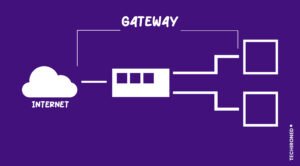A gateway in networks is a data transmission device that connects a wireless server to a host network. Outside the host network node bounds, the computer offers accessibility to a faraway network or an automated system. All information that is directed inside or outside the network must transit through the gateway and create a connection with it in order to be used by routing paths. A router is typically set up to serve as a gateway in computer networks.
In this article, we will see a detailed overview of gateways, the characteristics of gateways, and their advantages and disadvantages. You will be easily educated about networking gateways by the end of this post.
However, it is crucial to understand what gateways are, how they operate, and the many types of gateways before learning about their pros and downsides.
What are Gateways in Computer Networks?

A gateway is a device that can connect various network architectures. The gateways operate from the base layer to the top layer, or from the network layer to the application layer, in the OSI paradigm.
Routers and gateways are used in tandem. To connect two dissimilar networks, it can convert data packets from one protocol structure to another before transmitting them. The application layer, therefore, includes a protocol translation function.
The computer program that is configured to carry out that duty is referred to as the default gateway. It facilitates communication between networks and their connected elements, such as impedance matching, protocol translators, defect grounding straps, rate changes, and signal translators.
How do Gateways work in Computer Networks?
A network gateway is the hub of a number of networks with exposure to other networks. As a gateway node connecting the network to the intranet, the router serves as the “Gateway.” However, a particular computer acts as a gateway point for the traffic connecting networks in large enterprises. In a commercial setting, a computer server serves as a gateway node and, on occasion, can also operate as a proxy server or barrier.
Despite the fact that other devices can function well as a gateway, the gateway is a required property of routes. But in this case, the operating system that is being used for internet sharing acts as a gateway and connects to internal networks.

What are the types of Gateways in Networks?
According to the route of data flow, there are two different types of computer network gateways; each is described below.
Unidirectional Gateways
This kind of gateway enables data broadcasting in a single direction. There is just one way for the data to communicate; it cannot communicate in both directions. Every modification is made in the source terminal and replicated to the target application or node. The direction of the data is unaffected by the nodes, and it stays the same as when it was sent. Typically, this kind of gateway serves as an archive tool.
Bidirectional Gateways
Bidirectional gateways are the kind of gateways capable of carrying out a two-way data flow including both directions. Additionally, data can be delivered and received simultaneously. All modifications made to the source node are duplicated in the endpoint and vice versa in these gateways. These kinds of synchronization tools are capable of carrying out any task.
What are the characteristics of Gateways?
Among all network connecting devices, the gateway has the fastest data transfer speed and employs full-duplex communication.
It has effective traffic-control capabilities.
It is capable of fully converting protocols from one exclusive technology for computer networks to another technology. Instead of encapsulation, it means ethernet to token ring, FDDI, or another paradigm or protocol.
It requires OSI model levels above, presumably layer 7, the application layer. Various protocols, including IBM SNA, Internet TCP/IP, and others, can be changed from connection to connection.
Due to protocol conversion, gateways function irregularly in contrast to bridges and routers. As a result, they are able to cause obstructions to form blockages during periods of high operation.
What are the uses of Gateways in Networks?
We now know what a gateway is and the several varieties there are. Let’s, therefore, explore the role of the gateway in a computer network.
By serving as the connection point between sensors, internet machines, or other equipment, the gateways play a crucial function.
The gateways act as a gatekeeper for transmitting data and permit data from various networking devices with various protocols to enter or exit. Additionally, they are proficient at using the internet to send emails, browse websites, and engage in a variety of other activities.
Sensors can operate for longer periods of time thanks to gateways’ improved battery life.
The gateways can transfer or receive data from equipment that uses several protocols. Additionally, it converts the data using the accepted protocol and sends it in the appropriate way.
Additionally, it is used to reduce the number of sensors and other components that need to be connected to the internet in order to communicate data.
To know the importance of gateways in networking, check this link
https://www.youtube.com/watch?v=SXZC6D7TRfM
What are the Advantages and Disadvantages of Gateways in Computer Networking?

There are several positive aspects of gateways in computer networking; the following details each one:
Connectivity
Gateway improves network connectivity with other networks and aids in network growth by connecting numerous computers and other systems. This will make it possible for several computers to access the same kind of data.
Filtering process
A gateway’s filtering system is yet another crucial feature. Because without them, there is a risk of theft associated with any services that arrive at the gateway. Each data packet that passes through the filtering gateway is examined as part of the filtering process.
Security
Gateway supports user authentication, which enhances security. User ID and Password are deployed on the network gateway as a security measure, preventing unauthorized users from accessing any kind of data from the network. This not only safeguards private data but also guarantees that only authorized individuals can access the data.
Domain Management
The network provider can guarantee that they will be able to offer more collision and broadcast domains and thus more capacity. Gateways on a network can control the collision and broadcast domains.
Protocol Convertor
A gateway can transform data packets in addition to screening them to meet the requirements of the destination. In conformity with the specifications of the target network or architecture, it can also alter the database schema. For this reason, it is often referred to as the Protocol Converter.
Better Versatility
The gateway’s ability to convert all information from PCs as well as many sorts of systems gives your network more flexibility.
Disadvantages of Gateways in Networking
The problems and drawbacks of gateways in computer networking are numerous; each one is described here.
Configuration
Device configuration via a gateway is rendered considerably more challenging or impossible. Therefore, a qualified system administrator is required for this task.
Implementation
Typically, routers themselves are where gateways are put by default. This makes installing and configuring them more challenging for network administrators. In addition, the costs associated with the implementation process are excessive.
Time Delay
Network gateway requires extra time to translate information, preventing instant information flow. It accesses older cached information that has not been cleared. As a result, it can take longer to produce a precise result.
Connection Breakdown
Communication loss may result if there is a chance that the gateway will malfunction. Until the issue is fixed, devices on the other side will be unable to communicate.
Troubleshooting
Over the network that connects each linked computer, each uses a unique protocol. Every computer has to conduct its own troubleshooting whenever a problem arises.
Examples of Gateways
IOT Gateway
This gateway’s purpose is to offer a platform for entering and leaving data from the Internet of Things devices. And whenever it has to transfer the data to the cloud, it converts the data between the sensor protocol.
Media Gateway
It enables the transmission of accessible data in the form of either video or audio among the devices.
Payout Gateway
As they enable risk-free and secure money transfers between the devices, these gateways are incredibly useful.
Network Entrance
One of the most common and widely used gateways that offer a precise gateway to transmit data across two separate networks with different protocols is the network gateway. Therefore, there is a good likelihood that you will be using a network gateway if the two devices are distinct and use separate protocols.
Standard Gateway
These are the gateways that allow peripheral devices and their network to interact for data transmission without specifying the use of another gateway.
Telephone Trunk Gateway
The gateway for Voice lines is still in use. They support the connection of outdated equipment and satellites for effective communication. In general, if the device is not online, these gateways are quite beneficial for transferring data.
Email Security Gateway
This gateway is used to send emails that violate a company’s strategy or to transfer data for any nefarious intent.
Firewalls for Web Applications
These programmers assist in pushing traffic from or to a web server and keep track of the same information.
Final words
Hope you all got the idea of the advantages and disadvantages of gateway in networks. Stay connected and learn more with us.
